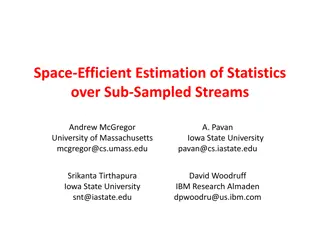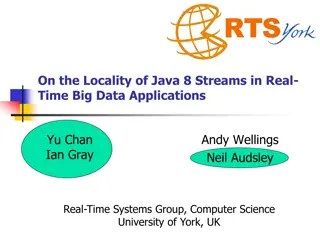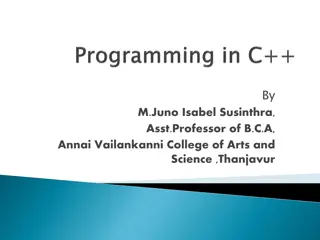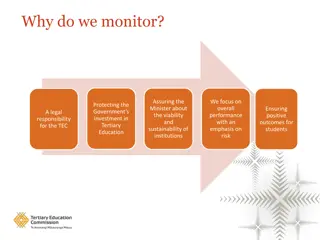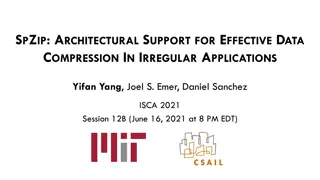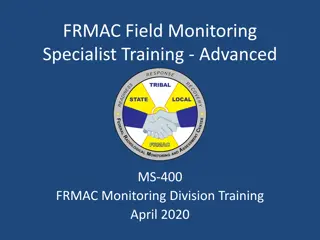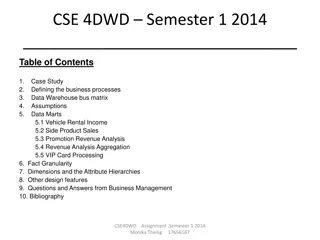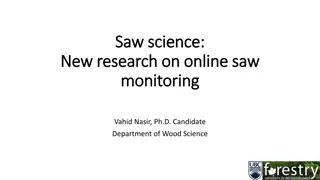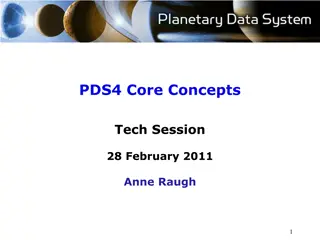Monitoring Streams: A New Class of Data Management Applications
Explore the challenges in implementing monitoring applications within traditional database management systems and the introduction of the Aurora prototype system designed to enhance support for monitoring applications by handling continuous data streams efficiently. The paper delves into the motivation, concept, examples, and architecture of monitoring applications, discussing how Aurora addresses the unique requirements of monitoring tasks such as detecting abnormal activity in real-time.
Download Presentation

Please find below an Image/Link to download the presentation.
The content on the website is provided AS IS for your information and personal use only. It may not be sold, licensed, or shared on other websites without obtaining consent from the author. Download presentation by click this link. If you encounter any issues during the download, it is possible that the publisher has removed the file from their server.
E N D
Presentation Transcript
MONITORING STREAMS: A NEW CLASS OF DATA MANAGEMENT APPLICATIONS DON CARNEY, U UR ETINTEMEL, MITCH CHERNIACK, CHRISTIAN CONVEY, SANGDON LEE, GREG SEIDMAN, MICHAEL STONEBRAKER, NESIME TATBUL, STAN ZDONIK VLDB 2002: 215-226 Presented by: Bharath Radhakrishnan Includes some slides by: YongChul Kwon (http://goo.gl/8K7Qa) Jong-Won Roh (http://goo.gl/Fzc3e) Under the guidance of: Prof. S. Sudarshan 16 September 2024 Advanced Database Management System
Outline 2 Motivation Monitoring Applications Special needs of monitoring applications Aurora System and Query Model of Aurora Operators in Aurora Aurora System Architecture Conclusion Extras Borealis Physically Independent Stream Merging
Monitoring Applications 3 Concept Monitor continuous data streams, detect abnormal activity, and alert users those situations Data Stream Continuous, Unbounded, Rapid, May contain missing, out of order values Occurs in a variety of modern applications
Examples of Monitoring Applications 4 Patient monitoring Aircraft Safety monitoring Stock monitoring Intrusion detection systems
Motivation Monitoring applications are difficult to implement in the traditional DBMS 5
Aurora 6 This paper describes a new prototype system, Aurora, which is designed to better support monitoring applications Stream data Continuous Queries Historical Data requirements Imprecise data Real-time requirement
Aurora Overall System Model 7 User application QoS spec Query spec Aurora System Historical Storage data flow (collection of stream) External data source Operator boxes Query spec 7/15 Application administrator
Representation of Stream 8 Aurora stream tuple: (TS=ts, A1=v1, A2=v2 .. An=vn) TS (Timestamp) information is used for QoS calculation
Types of operators 9 1. Continuous:-operate on single tuples 2. Windowed:- operate on a set of continuous tuples 1.)Slide 2.)Tumble 3.) Latch
Types of operators 10 1. Continuous:-operate on single tuples 2. Windowed:- operate on a set of continuous tuples 1.)Slide 2.)Tumble 3.)Latch
Operators 11 Filter --Drop Algebraic notation: Filter(P1, . . . , Pm)(S) Input stream Output stream Price > 1000
Operators 12 Map Applies a function to every tuple in the stream Map(A1 = F1, . . . , Am = Fm)(S)
Operators 13 Union Combine tuples from all input streams Union (S1, . . . , Sn)
Operators 14 Group By Partitioning condition Partitioning of input stream into multiple output streams
Operators 15 Aggregate Applies aggregate function on windows over input stream Syntax: Aggregate(Function, Assuming order, Size s, Advance I, Timeout t) (S)
Join 17 Join is a binary join operator that takes the form Join (P, Size s, Left Assuming O1, Right Assuming O2)(S1, S2)
Join Example Join( x.pos = y.pos, size = 10 min, X ordered in time, Y ordered in time) ( X,Y ) Y(sid, time, pos) X(sid, time, pos)
Aurora Query model 19 Queries can be classified as: 1.Continuous queries 2.Views 3.Ad hoc queries
Aurora Query Model (cntd.) 20 Continuous queries: Continuously monitors input stream QoS spec data input b2 b1 b3 app continuous query Connection point Picture Courtesy: Reference [2]
Aurora Query model: Views 21 QoS spec data input b1 b2 b3 app continuous query Connection point QoS spec b4 view b5 b6 Picture Courtesy: Reference [2]
Aurora Query model: Ad-hoc queries 22 QoS spec data input b1 b2 b3 app continuous query Connection point b4 QoS spec view b6 b5 3 days ad-hoc query b7 b8 b9 app QoS spec Picture Courtesy: Reference [2]
Aurora GUI 23 Operator Boxes
QoS specifications 24 Done by administrator A multi dimensional function specified as a set of 2D functions
Run-time Architecture outputs inputs Storage Manager Router Q1 Q2 Scheduler Qm Buffer manager Data Stream Box Processors Output Catalog Persistent Store Q1 Q2 Load Shedder QoS Monitor Qn Picture Courtesy: Reference [2]
Storage manager 26 1. Queue management Queue is present in main memory and disk. Storage manager implements a replacement policy to select which queue blocks to keep in memory
Storage manager 27 2. Connection point management Connection point stores historical data Data organized as a B Tree Default key is time stamp Insertions to B Tree are done in batched Periodic passes deletes tuples older than the history requirement.
Optimization 28 Optimization issues Large no. of small box operations High Data rates Architecture changes to the system
Optimization 29 Optimizations Dynamic Continuous Query Optimization Inserting projections Combining Boxes Reordering Boxes Scheduling related optimizations Adhoc Query Optimization
Optimization 30 Courtesy: Slides by Yong Chul Kwon Aggregate Join Map Filter pull data Hold Union Continuous query Filter Hold Ad hoc query BSort Filter Map Static storage Aggregate Join
Dynamic Continuous Query Optimizations 31 Optimize local sub-networks Inserting projections Combining Boxes: Combining reduces box execution overhead Eg : two filters into one etc Re-ordering boxes: 1. 2. 3. C(b) time taken by b to process 1 tuple B1 B2 B2 B1 S(b) Selectivity of box b Total Cost(B2-B1) = TC2 = C(B2) + S(B2) * C(B1) Total Cost(B1-B2) = TC1 = C(B1) + S(B1) * C(B2)
Optimizing Ad-hoc queries 32 Two separate copies sub-networks for the ad-hoc query is created COPY#1: works on historical data COPY#2: works on current data COPY#1 is run first and utilizes the B-Tree structure of historical data for optimization Index look-up for filter, appropriate join algorithms COPY#2 is optimized as before
Real Time Scheduling(RTS) 33 Scheduler selects which box to execute next Scheduling decision depends upon QoS information End to End processing cost should also be considered Aurora scheduling considers both
Real Time Scheduling(RTS) 34 Non-linearity :- Output tuple rate not always proportional to input tuple rate. Inter-box non-linearity (Superbox scheduling) Less buffer space thrashing Bypass storage manager with advanced scheduling Intra-box non-linearity (Train scheduling) Tuple processing cost could decrease if more tuples are available for processing (similar to batch processing) Reduced context switches
RTS by Optimizing QoS: Priority Assignment 35 Latency = Processing delay + waiting delay Train scheduling considers the Processing Delay Waiting delay is function of scheduling Give priority to tuple while scheduling to improve QoS Two approaches to assign priority a state-based approach feedback-based approach
Different priority assignment approach 36 State-based approach Assigns priorities to outputs based on their expected utility How much QoS is sacrificed if execution is deferred? Selects the output with max utility Feedback-based approach Increase priority of application which are not doing well Decrease priority of application in good zone
Load Shedding 37 Systems have a limit to how much fast data can be processed Load shedding discards some data so the system can flow Drop box are used to discard data Different from networking load shedding Data has semantic value in DSMS QoS can be used to find the best stream to drop
Detecting Load Shedding: Static Analysis 38 When input date rate is higher than processing speed queue will overflow B Input data ( Rate r(B) ) Output data ( 1/c(B)) s(B) Condition for overload C X H < min_cap C=capacity of Aurora system H=Headroom factor, % of sys resources that can be used at a steady state min_cap=minimum aggregate computational capacity required min_cap is calculated using input data rate and selectivity of the operator
Detecting Load Shedding: Dynamic Analysis 39 The system have sufficient resource but low QoS Uses delay based QoS information to detect load If enough output is outside of good zone it indicates overload Picture Courtesy: Reference [2]
Static Load Shedding by dropping tuples 40 We will prefer to drop tuples that result in minimum compromise on QoS. Find output graph resulting in minimum QoS drop Drop tuples (Drop Box) Recalculate resources. If insufficient, repeat process Get rid of tuples as early as possible Move the drop-box as close to the data source or connection point
Dynamic Load Shedding by dropping tuples Delay based Qos graph is considered Selects output which has Qos lower than the threshold specified in the graph(not in good zone) Insert drop box close to the source of the data or connection point Repeat the process until the latency goal are met
Semantic Load shedding by filtering tuples 42 Previous method drops packet randomly at strategic point Some tuple may be more important than other Consult value based QoS information before dropping a tuple Drop tuple based on QoS value and frequency of the value
Semantic Load shedding example 43 Load shedding based on condition Most critical patients get treated first Filter added before the Join Patients Drop barely Injured tuples Doctors who can work on a patient Join Doctors Too much Load
Conclusion 44 Aurora is a Data Stream Management System for Monitoring Systems. It provides: Continuous and Ad-hoc Queries on Data streams Historical Data of a predefined duration is stored Box and arrow style query specification Supports Imprecise data Real-time requirement is supported by Dynamic Load- shedding Aurora runs on Single Computer Borealis[3] is a distributed data stream management system
References 45 [1] D. Carney et al., Monitoring streams: a new class of data management applications, Proceedings of the 28th international conference on Very Large Data Bases, p. 215 226, 2002. [2] D. J. Abadi et al., Aurora: a new model and architecture for data stream management, The VLDB Journal The International Journal on Very Large Data Bases, vol. 12, no. 2, pp. 120-139, 2003. [3] D. J. Abadi et al., others, The design of the borealis stream processing engine, in Second Biennial Conference on Innovative Data Systems Research (CIDR 2005), Asilomar, CA, 2005, p. 277 289.
46 Picture Courtesy: Good Financial Cents http://goo.gl/MaQC0
Extras 47
THE DESIGN OF THE BOREALIS STREAM PROCESSING ENGINE DANIEL J. ABADI, YANIF AHMAD, MAGDALENA BALAZINSKA, UG UR C ETINTEMEL, MITCH CHERNIACK, JEONG- HYON HWANG, WOLFGANG LINDNER, ANURAG S. MASKEY, ALEXANDER RASIN, ESTHER RYVKINA, NESIME TATBUL, YING XING, AND STAN ZDONIK Presented by: Bharath Radhakrishnan Under the guidance of: Prof. S. Sudarshan 16 September 2024 Advanced Database Management System
Second Generation SPE Requirements 49 Dynamic revision of query results Consider newly available updates Dynamic query modification Automatic and fast modifications Flexible and highly-scalable optimization
Borealis 50 Distributed stream processing engine Extends the Aurora functionality Similar system architecture Developed to meet the new SPE requirements


